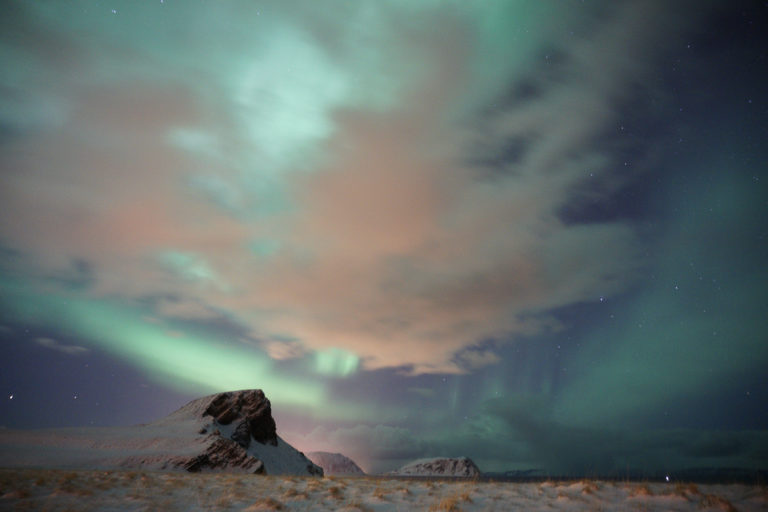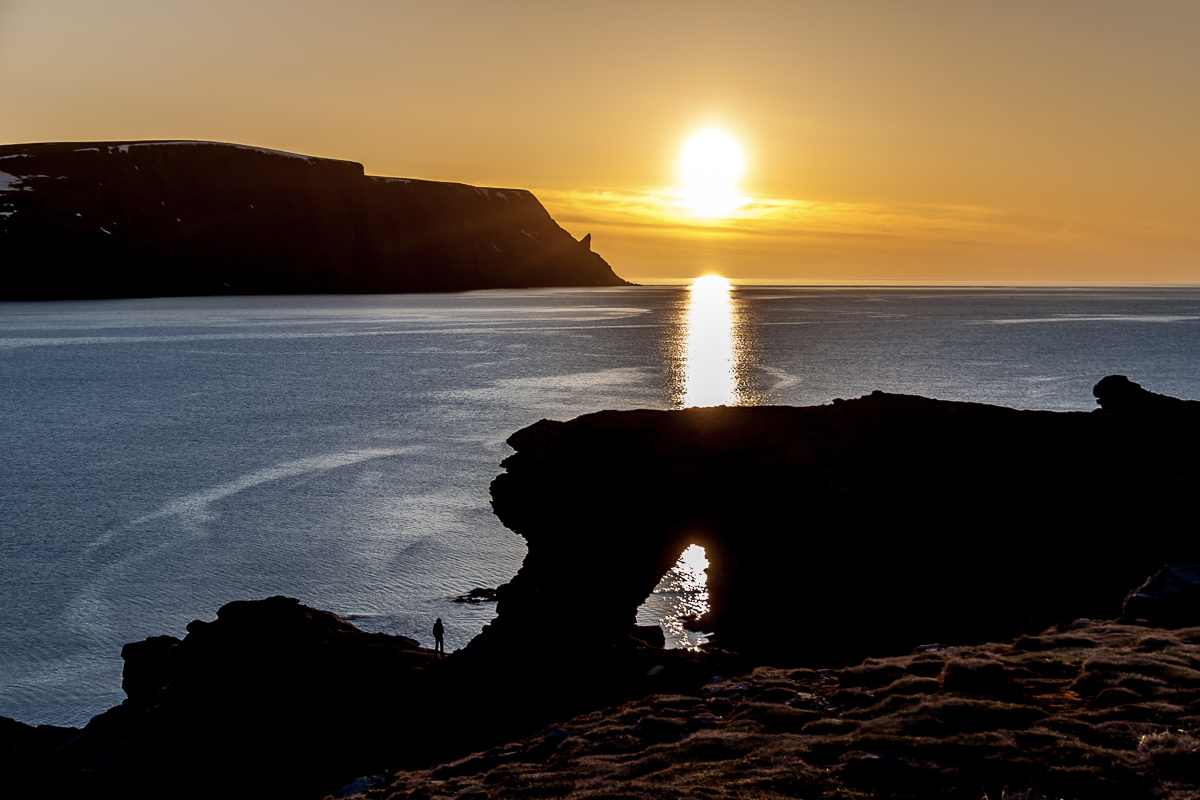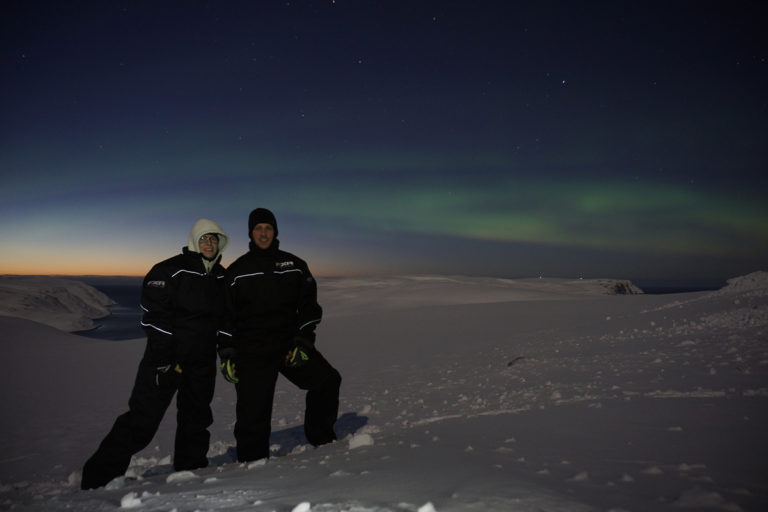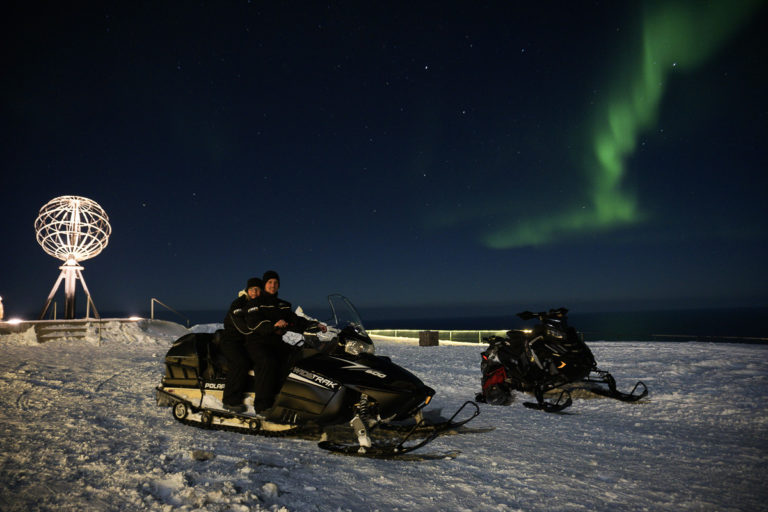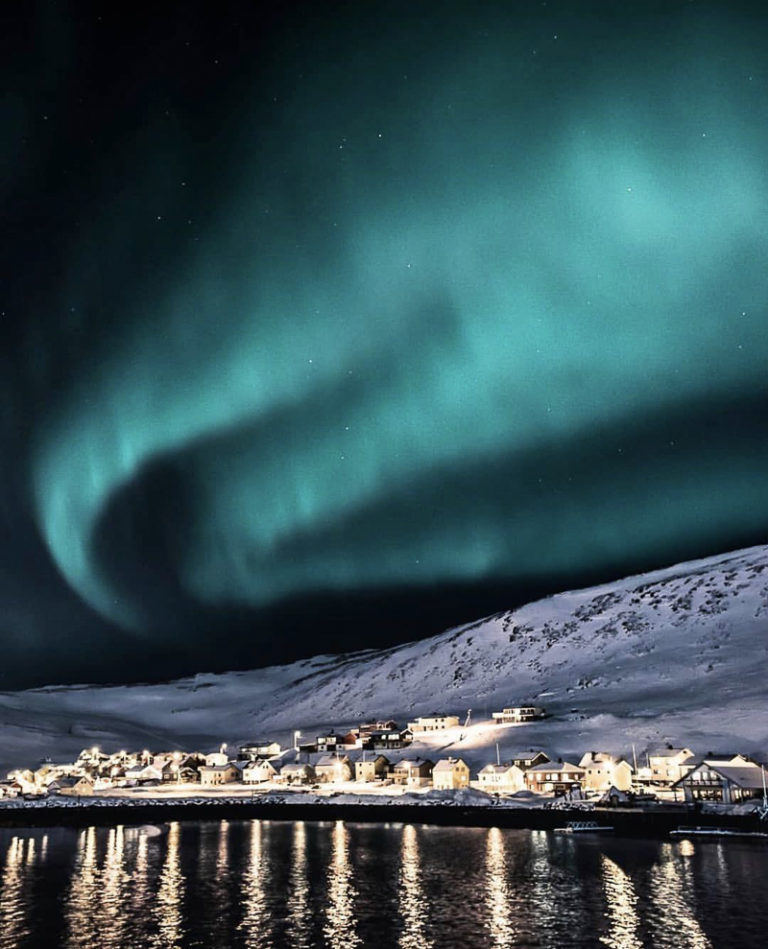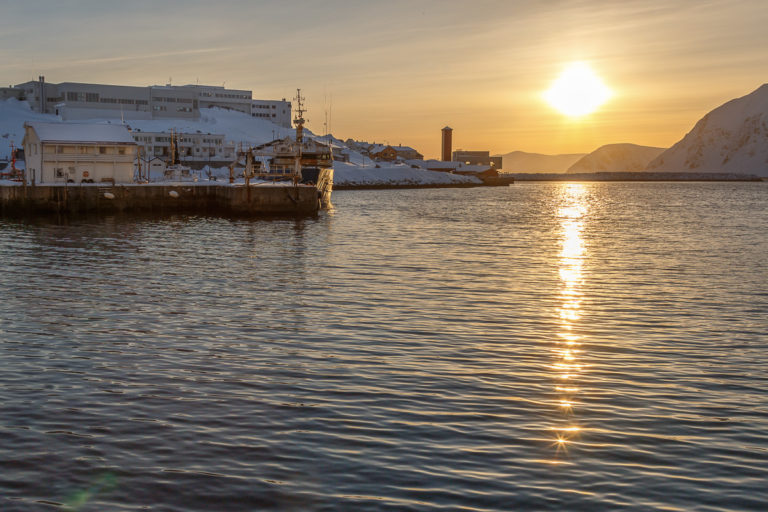Nordkapp, the North Cape, has been one of the major sailing marks of the world since 1553, when the English sea captain Richard Chancellor first named the promontory North Cape. Soon, the North Cape was a household name on the seven seas and one of the candidates for the title “the end of the world”. Today, one can easily reach the North Cape, and in summer it is a well visited place. The independent traveller, however, might want to experience the end of the world with that extra effort. Driving behind a snowplough or even getting there by snowmobile adds that little extra to the voyage to the end of the world.
Sometimes you are really lucky
Once I stood at the edge of Nordkapp, the North Cape, in late October. The temperature was +1 degree, there was no wind, the stars were out, and the moon crescent made a path of silver across the Northern Ocean. And there she was Aurora made several appearances, coming in every different direction. As we were about to leave, she flooded like a mighty white river with rivulets in pink, violet and green. It felt so close I felt I could reach for her. Never have I seen Northern Lights like this, and it happened at the end of the world. I felt I needed to see nothing more in life.
Sometimes you get more than you bargained for
The experience for the Australian couple in January 2020 was vastly different. They had booked an overnight stay at the cape itself. At first everything went to plan, but when they were about to return, an Arctic storm had hit. Even the ATVs had to be stored indoor, otherwise one wouldn’t be able to find them. For five nights, they were trapped at the cape. Indoor everything was nice and warm, and they kept Northern Norway well informed on what they were doing through the social medias. Imagine how many stories are told about it around the barbie down under.
Going to the North Cape in winter is an attitude thing
There is, as you understand, nothing guaranteed when it comes to experiencing the Northern Lights at the North Cape. Snow-laden clouds and strong northerlies can erupt at the snap of your fingers. Or storms from the south west make it rain incessantly in mid-winter past the 71st parallel. To some, this is way too much uncertainty. However, the experienced traveller, the one with a stomach to handle not being in control, will take on the challenge. If you make your North Cape voyage part of a larger winter tour of the north, you can be certain to have a rewarding trip with many things.
The North Cape convoy goes every day
The North Cape convoy is both an adventurous and a safe way of going to the North Cape in winter. The bus drives up to the Skarsvåg crossing. Here, a snow plough waits. Then the bus drives up the last kilometres to the North Cape by following the snow plough, and travellers in their own cars can come too. Driving to the North Cape might seem like a daring expedition; but you are inside most of the time, either in the bus or in the North Cape Hall. This means that going by convoy to the North Cape can be done by almost any traveller, regardless of physical shape. Plenty of clothes are a requirement, though.
The evening convoy allows you to see the Northern Lights
The evening convoy is there for to see the Northern Lights. The programme is the same as the daytime excursion, snow plough and all. However, now you get to stay up on the North Cape hall and wait for the Northern Lights. Again, the weather is a lottery, but among drifting clouds and changeable weather, there are Northern Lights more often than you think.
There are two – three convoys a day
There are one, possibly two convoys in the day to the North Cape. This allows you to see the Cape in daylight. Then there is the evening convoy, that gives you time in the evening on the cape itself. The North Cape Hall is then open, you can get your souvenir stamp, have coffee and see the cape. If you have good winter clothing and shoes, this is a safe albeit fresh experience. Things change quickly, however, so you could get in touch with the local Tourist Board, Visit Nordkapp.
There are more ways than one to get to the end of the world
We took a chat with Yves Jacobs, the Belgian born manager of the local tour company 71 grader nord. He specialises in active tours around the North Cape island of Magerøya year round. Well integrated into local life, he also has lots of tips about where to go and who to meet.
The ultimate way of seeing the Northern Lights as Nordkapp is by snowmobile
Yves recommends their tour to the North Cape, of course. From Honningsvåg to the Skarsvåg crossing, which is as far as the road is normally open, one drives by ATV. Those little tractor-like vehicles are great fun driving. You go on the road, rising up from Skipsfjorden to the plateau. If the Northern Lights show up, you stop. A particularly good viewpoint is Tufjordutsikta, from where you see the North Cape in the distance. At the Skarvåg crossing, you change from ATV to snowmobile and drive the last miles up to Nordkapp.
Imagine having the North Cape to yourself
If you go with Yves in a little group, you arrive at the North Cape in survival suits, allowing you to move around in any weather comfortably. The Northern Lights can never be promised or predicted, but if the skies are clear, you have a pretty good chance. The idea of reaching the end of the world on snowmobile is the main idea anyway, and a highly original way of adding the North Cape to the list of visited places.
The North Cape in winter is a different experience
If you arrive at the North Cape at daytime, expect cold and wind. Expect wading through snowdrifts, or balance on ice. Wind sweeping snow into your face… yes, it can be truly challenging. And that cup of coffee inside the North Cape Hall will feel like a relief. But the North Cape can surprise you with fluffy snow and lovely weather. In December, the pink and gold colours of the Polar Night bathe the landscape in soft colours, in late February or March, the sun is already high on the sky, and your long johns start to itch under the layers. After all, you are a mere 2000 km from the North Pole and must be prepared for everything.
Be prepared for a complete change of plans
All this can be cancelled. On short notice. Just like that. The tepid waters of the Gulf Stream move incessantly north, and meet the cold from the Polar vortex, that cushion of cold resting over the Arctic basin most of the time. Sometimes, this releases masses of energy, and the Finnmark coast is the victim of strong winds and heavy snowfalls. The airstrip closes, the Hurtigruten weathers the storm without calling at Honningsvåg and the bus is cancelled. There is nothing to do but to chat in the hotel reception or dare the windy, short walk to the nearest café. Then you can look out on the storm, the way Finnmark people have done for thousands of years. It just can’t be helped.
As soon as it’s over, Finnmarks is back on track
Often, these strong winds calm rather quickly. Then the snow plough drivers do extra hours in opening closed roads, the staff at the airport does its best to get people on the planes available and roofs are shovelled in a swift, experienced manner by the locals. It has all been done before, and soon everything is back on track. Extreme weather at the North Cape happens every winter. But it doesn’t happen every week of the winter, most days the convoy can leave. Glorious sunshine, snow showers, drifting snow, all kinds of weather can be expected. But it is all handled by able and experienced staff and dressed up in layers you are never in any sort of danger.
The winter is a long-lasting pleasure at the North Cape
Most tourists come in the few weeks we can call summer. Honningsvåg and the North Cape, however, are engulfed in deep snow from sometimes in November (could be December) to May. Temperatures, however, are never that extreme, they hover around the -5C mark. Don’t be surprised by a rainstorm in the middle of winter. The other extreme is -15-20C when the southeasterlies bite your cheek and bless you with clear skies and good Northern Lights chances. Cold temperatures are most likely in February, already in March daytime temperatures are on the rise.
Winter comes in two versions, the dark and the bright one
From the 20th of November, when temperatures can still be mild, the sun sets for the last time at the North Cape, and the Polar Night begins. However, there is a twilight in the middle of the day, often with wonderful light. Even at solstice, the sky can be ablaze with golden and pink colours in the south at mid-day. However, at the 22nd of January, the sun is back, celebrated with the Sunshine Winter festival. Daylight has started its slow but steady takeover. Already in February, you can be out for hours in sun and snow. March is even brighter, and in April the night goes from black to blue before vanishing around Mayday.
The Northern Lights are seen from late August to mid April
When do you have a chance to see the Northern Light around the North Cape? Well, you need one imporant requirement; darkness. From late April to mid August, there is no darkness, and no background for Aurora to dance. The first lights can be spotted in the latter half of August, but from around mid September you have good chances of spotting them. The good times last until the end of March, but then the chances quickly diminish.
Explore the Magerøy Island on your own
If you have already been to the cape, or you just want your own experience, you could hire a car for the day. The North Cape Island of Magerøya is a most peculiar winter landscape, it looks like a cake, with steep sides and a flat top. In addition to Honningsvåg, there are three other settlements, each with their own personality. You can drive around in the daylight to see the landscapes, or at night to get your own Northern Lights shots. This is recommendable for anyone with driving experience from winter conditions, if you have never driven on snow, the North Cape may not be the place to start. If the car rental says the weather is too bad for driving around, you head for the nearest café instead.
Gjesvær is a picturesque village on the western side
A good 100 people live in Gjesvær, which is less than an hour’s drive west of Honningsvåg. The bay is filled with little islands, the Gjesværstappan. Some of the islands rise in peculiar shapes and make good photo motifs. The village itself is compact, colourful, and picturesque, and offers many photo ops. For that great overview, stand in the hillside above and take it all in. And then walk around the village. Maybe someone can open the little chapel for you. It is filled with contemporary art.
Skarsvåg is the world’s northernmost fishing village
Today, only some 30 people live in Skarsvåg, which proudly calls itself the world’s northernmost fishing village. A few decades ago, the number was 250. Walk around the dockside and look at the nets and fishing gear and photograph the boats on the bay. There is a small shop with limited opening hours, where you can also have coffee and shop Christmas déco.
Walk to Kirkeporten in winter
If the weather if okay, and you are in reasonable shape, you can do the hike to Kirkeporten, the “Church gate”. This is a natural arch, and through the arch you see the characteristic horn of the North Cape. You do the hike in around half an hour, but if there is a lot of snow, you should hire snowshoes. Go there in the daytime for that North Cape photo or try to photograph the Northern Lights and the gate.
Snowshoeing and Northern Lights
One safe and good way to the Northern Lights is to go snowshoeing. If you are used to this, just hire some snowshoes and walk to the nearest mountain, a headlamp is also a good idea. Maybe you drop by the Tourist Information for some suggestion. Those less familiar with tennis rackets on their feet may want to book a guided tour with Yves. That way, you also get a bit of info about the area and get taken to some nice viewpoints. There is no such thing as a Northern Lights guarantee but being out and about under the open sky certainly gives you the best chances.
Imagine that a monster could taste so good
The culinary highlight of the area comes in an unexpected place; at Sarnes about where the tunnel from the mainland comes up. Here you get freshly caught king crab. Go on a wharf and see a live crab fished from a cage-like pot on the seabed, you even get to hold it. It is then boiled in salt water. Served with bread, salad, and mayo, with the possible addition of a glass of white wine, it is both a rustic meal in an unassuming place in the north, as well as truly exclusive. The generous portion of king crab would be unthinkable in Oslo, where the tasty meat is almost worth its weight in gold.
Honningsvåg is a colourful town
Honningsvåg, the nearest town to the North Cape, is a small town of some 2800 people. It is found on the southern side of the North Cape island of Magerøya. Earlier, people lived in many small villages around the shores of the island, because when you sailed and rowed, you wanted a short distance to the fishing grounds. However, when fishing boats got engines, one could live in more sheltered locations. Honningvåg thus took over at the main centre of the area in the late 19thc. In 1944, every building in town was razed to the ground by the retreating Nazi forces, and the population was forcibly evacuated. Only the 1885 church survived.
“Little Chicago” used to be a rowdy place
In the 1950ies and 60ies, Honningsvåg was a centre in the lucrative cod and capelin fishing. Big factory trawlers delivered to big fish factories. Trawler crews from all over Norway and abroad raided the local bars, steered by thirst and hormones. The result was a rowdy night scene, earning Honningsvåg the nickname “Little Chicago”. Today, a lot of the fish is processed on board, so fewer crews arrive. This means nightlife is a bit more sedate. The good old days are revived by “Perleporten” (“Perly gate”) a local cabaret group you might come across during your visit.
Explore Honningsvåg on your own
This town of 2800 people has an attitude, not least because it has unilaterally declared itself a city, the world’s northernmost. The motivation is partly to pull the leg of the good citizens of the city of Hammerfest, slightly further south and proudly calling itself the world’s northernmost. Honningsvåg has a long-standing, loud and endlessly humorous rivalry with the southern neighbours. Walk the seafront walkway and view across the Magerøysundet up to the picturesque church, and continue up to the hillside to the sculpture depicting the filmmaker Knut Erik Jensen for an instant full view of Honningsvåg.
Honningsvåg has plenty of places to meet the locals
Some of the “Little Chicago” atmosphere can be relived at “Nøden” – the traditional bar. “Nøden” – “the need” or “the urgency”, used to be called Ritz, but was nicknamed Nøden because you were admitted here when you were refused entry elsewhere. Today’s clientele has dried up considerably, but they are still as friendly and talkative as back in the days. Don’t ask for wine coolers, though. “Corner” is another place that has been around for ever, and the place for lunches, informal dinners and that tipple. The King Crab House serves…you guessed it… King Crab. More upmarket eating can be had at the Scandic Hotel.
Where do you stay near the North Cape?
One hotel stays open all year in Honningsvåg, the Scandic Bryggen. There are also a couple of guesthouses, including the comfortable “The View”. You can also stay in comfortable holiday homes in Sarnes outside Honningsvåg , and Cape Marina, a small holiday village at the hamlet of Skarsvåg. Small establishments need prebooking in winter, as they may close down if they don’t expect guests.
Learn to take aurora photographs
How do you get to Honningsvåg and Nordkapp?
Honningsvåg is well connected with by plane. There is an airport for propeller planes, and the airline Widerøe flies from Tromsø and Hammerfest. The legendary Hurtigruten calls at Honningsvåg twice a day, and constitutes a both practical and beautiful connection to Hammerfest, Tromsø and Kirkenes for travellers. The airport in Alta is serviced by 737’s from competing airlines, and has access to a lot of discount airfares. The bus ride from Alta across the Sennalandet high plateau is very scenic.
Combine the North Cape with Alta and Hammerfest
Honningsvåg and Nordkapp, the North Cape, are fascinating, out of the way destinations. Nearby Alta compliments Honningsvåg with a stable climate with very good Northern Lights chances. There are also a lot of snowmobile and dogsledding options, as a well as an igloo hotel. Hammerfest is scenic, historic and atmospheric. Together, this end-of-the-world troika can provide an entertaining, varied and beautiful winter holiday for a week or two for the independent traveller.
Good to know about the North Cape
The North Cape, Nordkapp in Norwegian, is found on the island of Magerøya, at the very northern end of Norway. This is the Northern End of Europe.
Well, things are not always what they seem. There is a cape just west of the North Cape that is in fact about a kilometre and a half further North, Knivskjelodden. The North Cape, however, is a well know sailing mark since the 16th c., so by tradition we count the North Cape as the end of the world. Both these points are on an island, Magerøya. The northernmost point on Europe’s mainland is Kinnarodden, on the neighbouring Nordkyn peninsula.
You can drive here all year, although conditions can be tough in winter. There is a small airstrip with frequent departures to Hammerfest and Tromsø. Hurtigruten sails here every day. You can also fly to Alta, which has a good selection of discount fares. From there, there is a bus to the North Cape. If you want to combine Alta, Hammerfest and Honningsvåg/North Cape, there are daily buses between the three, a speedboat between Hammerfest and Alta, and the famous Hurtigruten between Hammerfest and Honningsvåg.
In winter, you can stay in Scandic Hotel Bryggen. There are also guest houses in Honningsvåg, and holiday homes in Sarnes and Skarsvåg. Prebooking is essential in winter, especially in small places. There are so few tourists that they might close if nobody is expected.
Nordkapp is the Norwegian spelling for the North Cape. In English, one can use the two interchangeably. In fact, the cape was first named North Cape in English in 1553, long before this name was in use at all in Norwegian. Another historic spelling is Noordkap, the Dutch spelling. The Dutch were active in the area in the 17th C., and were well familiar with the cape. Cap Nord in French, Nordkap in German, Cabo Norte in Spanish, Caponord in Italian… it goes on. Before all this happened, the cape was known as Knyskanes, but this name is not used anymore.
We are on top of the planet, so the twilight is long and brighter than you think. If the weather is good, you can expect a couple of hours of pretty good daylight even on the North Cape. Around the 23rd of January, the sun is above the horizon for a moment at mid day. In Februrary-March there is plenty of daylight, but at the same time, there is plenty of Northern Lights in the most active time in the evening.
The first lights are visible in late August. By mid September, you have good condition, lasting until the last days of March. By mid April, the lights are mostly gone.
















